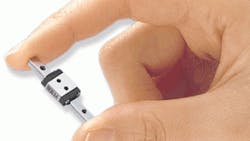Testing tiny wafers demands miniature moves from linear slides
As an engineering director involved in automation design and development, Mark Filho recognized the need for accurate positioning in this industry, so he established Newmark Systems Inc., Rancho Santa Margarita, Calif. Its first customer — 15 years ago — needed a compact positioner for semiconductor wafer probing, an operation that occurs before wires are attached in the burn-in for final chip encapsulation. A probe checks the circuits and capacitance of dies or chips in the wafer, to verify whether the dies are functional and meet specifications. Next, the wafer is scribed and sliced into discrete semiconductors.
The future is miniaturization
The miniaturization of microprocessors was and is clearly the wave of the future, which in turn necessitates the miniaturization of fabricators and testers. Consider Newmark's NLS4 linear positioner, which runs from 2 to 24 in. and carries up to 25 lb on a 9-mm rail system. It was optimized for stability using FEA analysis, and incorporates miniature linear guides from NB Corp., Hanover Park, Ill., including two guides and four blocks.
Though there are instances for which no preload is desired — and designers trade accuracy and rigidity for reduced friction — high-accuracy applications such as wafer probing are an exception.
All NLS4 series stages are machined from 6061 aluminum alloys for weight reduction and stiffness. The drive uses a stainless steel ACME leadscrew with a zero-backlash plastic drive nut that automatically adjusts for wear.
Smaller still
Certain applications — from robotic pick-and-place to medical devices — require a greatly reduced footprint. For these, Newmark created a linear stage with one guide and bearing, instead of the usual two. This tiny positioner — the MSL — can lift 15 lb. and move at 3 to 4 in./sec; a lone linear guide bearing from NB Corp. supports the carriage over the MSL's entire 25 to 200 mm travel. What else? The MSL has two leadscrew pitches (2 and 10 mm), and comes standard with a size-17 stepper motor and end-of-travel limit switches. Like Newmark's other positioners, it is completely enclosed so that the guideways and screws are not visible — and its friction-free miniature guides show no signs of wear, even after one-and-a-half years of constant travel.
For more information, contact NB Corp. of America at (800) 521-2045.
About the Author
Elisabeth Eitel
Elisabeth Eitel was a Senior Editor at Machine Design magazine until 2014. She has a B.S. in Mechanical Engineering from Fenn College at Cleveland State University.
